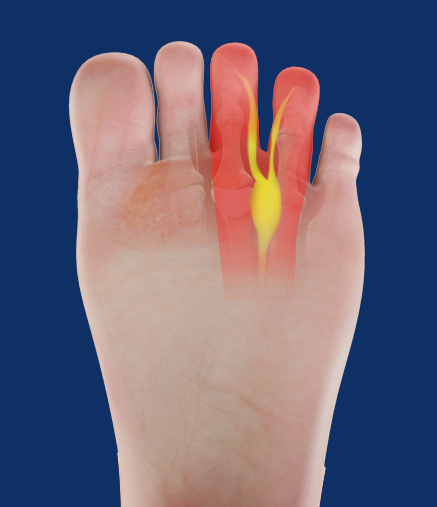Excision of Morton’s Neuromas
WHAT IS AN EXCISION OF MORTON’S NUEROMA?

If you sometimes feel that you are “walking on a marble,” and you have persistent pain in the ball of your foot, you may have a condition called Morton’s neuroma. A neuroma is a benign tumor of a nerve. Morton’s neuroma is not actually a tumor, but a thickening of the tissue that surrounds the digital nerve leading to the toes (the nerve that passes under the ligament connecting the toe bones [metatarsals] in the forefoot).
Morton’s neuroma most frequently develops between the third and fourth toes, usually in response to irritation, trauma, or excessive pressure. The constant pressure on the nerves that lead to the toes results in the thickening of the tissue that surrounds said nerve, causing Morton’s neuroma. Women who frequently wear high-heeled or narrow shoes experience Morton’s neuroma due to the compression of the toes and pressure of the ball of the foot. High-impact sports and activities such as running may also cause Morton’s neuroma.
The incidence of Morton’s neuroma is 8 to 10 times greater in women than in men.
MORTON’S NEUROMA TREATMENT
The sooner Morton’s neuroma is diagnosed, the greater the chance you will not have to undergo surgery. The non surgical treatment options for Morton’s neuroma include taking medication, getting steroid injects, and even changing your footwear, however, in severe cases of Morton’s neuroma, surgery is required.
A simple, yet effective course of action you can take for Morton’s neuroma treatment is purchasing and wearing the proper footwear. This includes non-restrictive shoes with good arch support that allow plenty of room for your toes. Other Morton’s neuroma treatment involve getting plenty of rest and avoiding activities that could put excessive pressure on the foot. If needed, ice may be applied to the affected area and gently massaging of the foot and toes to relive pain may help.
Depending on your doctor’s approval, moderate exercise to improve flexibility and strength of the arch and foot may also be advised to help alleviate pain. Gentle stretches of the muscles in your foot, calf, and lower leg to help strengthen the foot may be advised.
EXCISION OF MORTON’S NEUROMA
If non-surgical Morton’s neuroma treatment does not work, surgery will be required. An excision of Morton’s neuroma eases the pain by releasing pressure from the nerve or removing the nerve all together. In an excision of Morton’s neuroma treatment, your surgeon will make an incision on either the top of the bottom of your foot in order to cut out a small portion of the affected nerve or release pressure of the tissue around the nerve.
RECOVERY TIME FOR MORTON’S NEUROMA TREATMENT
The recovery time for an excision of Morton’s neuroma is generally short. For the first two weeks after Morton’s neuroma treatment you will be required to wear a post operative boot or sandal that allows you to walk without putting excessive pressure on the foot. After two weeks, your bandages will be removed and you should then be able to transition back to wearing comfortable fitting shoes. Pain and swelling vary depending on the patient. It is advised to continue resting the foot when needed and avoid strenuous activities until told otherwise by your doctor.
FAQ
What are Morton's neuroma excision success rates?
Morton’s neuroma removal generally has high success rates, with most patients reporting considerable improvements in pain and other issues.
What alternative therapies are available for Morton's neuromas?
What can be done to avoid Morton's neuromas?
Wearing comfortable, properly fitted shoes, avoiding high-heeled footwear, and maintaining a healthy weight to relieve strain on the feet are all significant preventative measures for Morton’s neuromas. Exercises that include stretching and strengthening may also enhance foot health and lower the likelihood of Morton’s neuromas.

